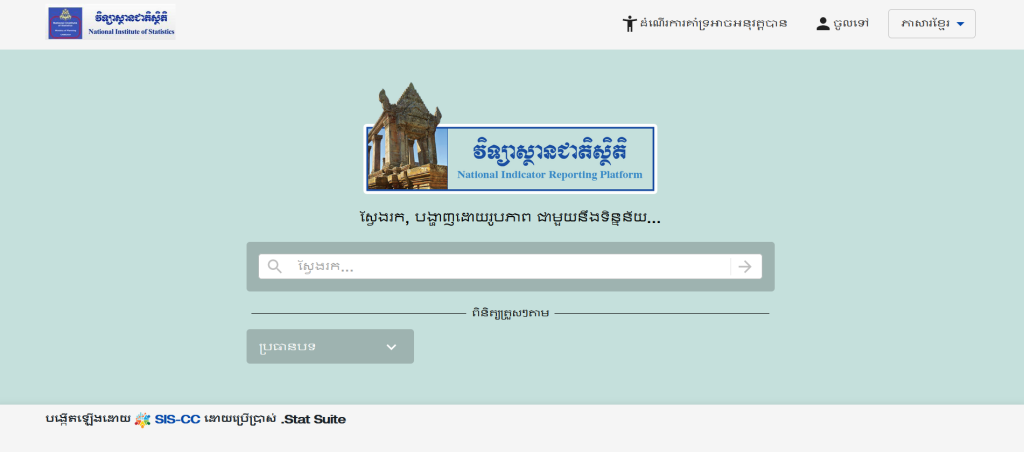
To implement data dissemination and reporting on the Sustainable Development Goals using latest good practices, the National Institute of Statistics of Cambodia successfully leveraged the open-source data platform .Stat Suite, the global data exchange standard SDMX and the power of the Statistical Information System Collaboration Community. Building on this example, national, regional and global partners are now in the position to move towards a harmonised approach and use of these technological advancements.
The Challenges and Needs
Almost nine in ten national statistical offices (NSOs) identify the strengthening of online data dissemination platforms and tools among their top priorities to enhance data dissemination, a global study among NSOs in 2021 found.
In Cambodia, the need to rethink dissemination tools and practices in place emerged back in 2015. At the time, the United Nations-developed data management system for the Millennium Development Goals, backing Cambodia’s official reporting platform CamInfo, was being sunsetted, urging the National Institute of Statistics of Cambodia (NIS Cambodia) to migrate a wealth of statistical data.
With the onset of the Sustainable Development Goals (SDGs) in the same year, the vision was to make SDG indicators available to the broadest possible audience. Hence, embracing international and national data exchange based on global standards was critical to succeed.
The Community Approach
NIS Cambodia was committed to responding to data user demands, new reporting requirements and evolving practices for global data exchange. The selection of the country’s future reporting and dissemination platform was an important first decision, which was based on internationally recognised principles and guidelines. To foster interoperability of solutions and data, principles like clear institutional arrangements and platform management, fitness for purpose, sustainability as well as statistical standards, such as the ISO standard Statistical Data and Metadata eXchange (SDMX), were considered.
The .Stat Suite, a standards-based, componentised, open-source platform, appeared to be a strong candidate to meet these requirements. With the Statistical Information System Collaboration Community (SIS-CC), a reference open-source community for official statistics hosted at the Organisation for Economic Cooperation and Development (OECD), the project gained a partner with shared values and committed to following globally agreed data platform guidelines such as national ownership, collaboration and scalability.
Assessing statistical capacities and resources
Since 2018, the project has gone through several stages, starting with a situational analysis and assessment of current capacities, infrastructure as well as data processes and data flows to define the vision of the target product next to training and capacity needs. This initial phase of the pilot was led and funded by the United Nations Children’s Fund (UNICEF) with support from the Partnership in Statistics for Development in the 21st Century (PARIS21), SIS-CC and OECD Statistics and Data Directorate.
One of the goals of UNICEF’s Gates Foundation-funded Helix project was to test the application of standards-based tools with national statistical systems that used the DevInfo platform, which was being sunsetted. We saw Cambodia as an ideal partner for this project with a strong UNICEF Country Office ready to provide support locally.
Yves Jaques, Chief, Frontier Data and Tech Unit, UNICEF
In addition, the United Nations Statistical Division (UNSD) participated to support in the areas of SDG reporting and data modelling according to SDMX best practices. Cambodia was also included in UNSD’s FCDO-funded project on SDG monitoring aimed at improving the availability of national indicators.
Step-by-step data modelling and migration
As a next step, the team exported CamInfo data and extracted it in spreadsheet format ready for cleaning and modelling (Figure 1). By the end of 2018, together with NIS Cambodia staff, the team was able to identify and model all CamInfo education, demography and agriculture indicators, using a common data structure and standard code lists. Companion software developed by partners assisted in the creation of code lists as well as data flows and the mapping of data in CamInfo. To upload SDMX structures and data, the team used the .Stat Data Lifecycle Manager.
Simultaneously, starting early 2018 the NIS participated in pilot SDMX exchange of SDG indicators and worked with partners to map its national SDG indicators according to the global SDG Data Structure Definition.

The Results
The migration process starting in 2018 saw several partners join forces with NIS Cambodia to support the transition of more than 55 datasets in SDMX, about 900 indicators and over 170,000 observations from the DevInfo-based CamInfo to the new .Stat Suite-powered CamStat (Figure 2), which was hosted temporarily by UNICEF and OECD. Following this milestone, the work was completed in October 2020 with the installation and launch of the bi-lingual CamStat in a robust cloud environment on the United Nations Global Platform (UNGP).

Realising the benefits of the cloud and SaaS for official statistics
The .Stat Suite Software as a Service (Saas) model and UNGP cloud environment allowed the deployment of the .Stat Suite without the need for locally hosting servers, building complex infrastructures or worrying about additional security plans. The solution offers even more benefits such as automatic backups and restoration of statistical data, scalability, minimised costs and deployment of a new .Stat Suite instance in as little as one day excluding design customisation. The UN Global Platform community has provided the deployment and maintenance of the .Stat Suite software, enabling the NIS to focus on its core data management competencies.
The project in Cambodia is a real success story not just from a technological perspective, but also in terms of international statistical cooperation. The key question behind our motivation and efforts was how can we deploy CamStat to the cloud-native UNGP in a way that is replicable for other national statistical offices.
Ronald Jansen, Assistant Director, UNSD
Despite the absence of on-premises infrastructure, this approach promotes national ownership in line with UN guidelines, enabling NIS Cambodia to manage and add statistical data at any time. Similarly, sustainability of knowledge and practices within NIS Cambodia has been ensured thanks to a range of workshops on SDG reporting, data sharing protocols, data standards and modelling. By the end of 2020, the NIS fully took over the data management, and has since independently operated CamStat, maintaining and expanding its datasets as well as data exchange with the SDG Global Platform.
CamStat is proof that advanced technologies can be used successfully in developing countries
Looking back, the project saw NSO staff, technology providers, capacity development experts, international partners and country representatives sharing knowledge and resources to successfully build and strengthen the foundations for enhanced SDG data dissemination and interoperability.
However, for advanced technologies to gain a foothold in developing countries, there is a clear need for a more sophisticated ecosystem of standards-based cloud services tailored to the needs of NSOs that prevent vendor lock-in and are consistent with long-term NSO goals of self-reliance. The UN Global Platform is a cooperative cloud environment of the global statistical community with services that can meet those tailored needs.
NIS Cambodia immensely benefitted from this project bringing together partners of distinct profiles and capacities striving for a common goal. With the cloud-based solution and the .Stat Suite, we identified an opportunity to reduce the costs of Cambodia’s new official reporting and dissemination platform.
Lay Chhan, Deputy Director, National Institute of Statistics, Cambodia
While the project drew to its conclusion, the collaborative approach behind it lives on and helps avoid reinventing the wheel elsewhere. The Food and Agriculture Organisation (FAO) and Economic and Social Commission for Asia and the Pacific (UN ESCAP), for example, adopted the approach and leverage common open-source tools and standards-based approaches to data modelling to foster the dissemination of agricultural data.
About CamStat
CamStat serves as the official data dissemination portal of the National Institute of Statistics of Cambodia (NIS Cambodia) providing more than 55 datasets and about 900 indicators. Between 2018 and 2020, NIS Cambodia migrated the former DevInfo-based platform named CamInfo in a collaborative fashion with several international partners. The new .Stat Suite-powered CamStat now runs in a cloud environment on the United Nations Global Platform. http://camstat.nis.gov.kh/


